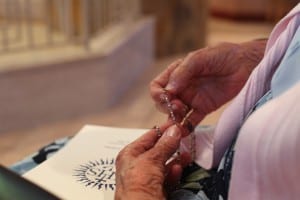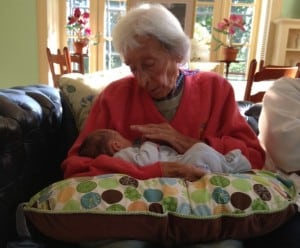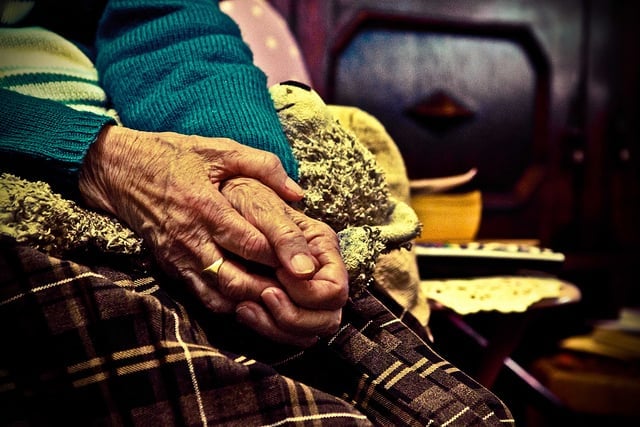“Meem?” my seven-year-old self asked my seventy-something grandmother as we rode together in the back seat of her car. “Meem” was short for “Mimi,” which itself was short for “Mary.” It was nighttime, summer at the beach, and I was staying with her and my grandfather.
She turned to me, eyebrow arched, awaiting my question: “Well, um, what happens when you…you know…?” And I lifted both hands skyward, towards the stars, the clouds, the roof of my grandparents’ Green Chevrolet sedan.
Death was a word and a reality that, apparently, rendered me temporarily mute and dependent on a seven year old’s sign language. I was not asking “So, what happens when someone dies?” I was asking what would happen when she, my grandmother – the lady who had just bought me funnel cake at the Ocean City boardwalk – died. I’m not sure why it dawned on me at that moment that she would not be with me forever, but I do remember it dawning. I remember that it was a sad, sober moment.
Fortunately, she correctly interpreted my gestures. Unfortunately, I cannot remember how she replied – except that it was not with the lie I most wanted to hear (“Don’t worry, Timmy. I’ll never die.”). I do remember that even her hypothetical death depressed the hell out of me. So I did what any seven year old of Irish extraction would do: I brooded about it in my room once we got home. Brooded, that is, until I realized that she was still very much alive, and probably eating ice cream and watching the Phillies game upstairs. So I did what any seven year old would do: I went and joined her.
* * *
“The church’s women are its future.” This was the confident, stage-whispered proclamation of one of my fellow churchgoers to her friend. We had just celebrated, quite movingly, baptism and confirmation for a large group of young women and men at the Easter Vigil.
I resisted the urge to interject: “The church’s women are its past and present, too.” But spoken or not, the fact remains: women are the church’s future, and its present, and its past.
If you have spent any time around Christian churches, Catholic or otherwise, you know one thing for certain: women run the church. From religious sisters to lay female ministers, school teachers and administrators of all kinds, social workers and choir members: Christ’s work on earth today is disproportionately carried out by his female disciples. John Henry Newman’s famed quip about the laity in general – that “the church would look foolish without them”1 – is doubly true of its women. Practically speaking, without them there would not be very much to call “church” in the first place.
What is true at the level of church works and ministries is true of the transmission of faith itself from generation to generation. Christian belief and worship is inherently communal – a “we” rather than a solitary “I.” And, with all due respect to the famous hymn, for many of us Christianity is more accurately the faith of our mothers.
It has been this way since Christianity’s earliest days. Paul,2 writing to Timothy, says “I yearn to see you again…as I recall your sincere faith that first lived in your grandmother Lois and in your mother Eunice and that I am confident lives in you also” (2 Tim. 1:4-5).
These words have become important for me, not because my name is Timothy but because it describes my own experience: I received the faith from the women in my life. It’s from them I that believe. So too with many of us: from them, we believe. Women and men, old and young. We come to believe – together.
* * *
My family’s affection shortened my grandmother’s name from Mary to Mimi to “Meem.” This did not shorten her life. When she died in March of 2013, she was 94. Hers was a beautiful life and, in the end, a beautiful death.
For years though, especially after my grandfather died, she struggled with her faith. Mortality was no longer far-off reality, hovering on a distant horizon. Now it was here, concrete. And now the sureties of faith – especially about life after death and about what awaits us – felt, well, less sure. She struggled, in other words, with the very same question I asked her twenty-some years beforehand. What was most striking was that in these questions and doubts she turned to us, and particularly my mother and father and aunt, just as I had turned to her. And she found in our family, as I had, support and strength.
When our faith falters, as it sometimes does and perhaps must, we are supported by others. If we are open to it. Often we are upheld by those to whom we have handed on the faith. This is mysterious and counterintuitive and unspeakably beautiful. We believe. Together.

Meem’s Hands at Prayer
Mimi’s physical diminishment was inversely proportional to her spiritual engagement. Even as her mind swam with questions about faith, her heart turned to God. Visiting home, I would often see her in a bedroom chair, passing the beads of a rosary through her fingers, blissfully unaware of my presence in the doorway. I would never interrupt. On the day I professed my vows as a Jesuit, my brother-in-law snapped my favorite picture of that day: Meem, waiting for the Mass to begin, working that rosary.
My physical distance from Mimi in her last years was considerable. (Jesuit formation is many things, but it is rarely “local.”) Especially in her last months, I found myself praying the rosary much more often. Less so after she was gone. I realize why: that prayer was my way, subconscious perhaps, of staying close at a great distance.
* * *
My sister was pregnant with her first child about the time Mimi’s health truly began to fail. Pardon the phrase, but she was hell bent on living to meet that baby. By the time my nephew arrived in mid-October, Meem had weathered a series of mini-strokes. Living with my aunt by that time, Mimi was the first stop the new babe made on his way home.

A Blessing Across the Generations
I remember first seeing this picture. She looks like she’s blessing my nephew, and I have no doubt that, in some sense, she was. And slung over her left shoulder? A well-worn rosary, of course. For my part, a blessing on my family for snapping this shot, and a blessing on Apple for inventing the iPhone. They brought me closer to these first and last moments of life than I actually was.
If I am making my grandmother sound like a pious old lady sent up from Central Casting, that’s not my intent. She was not that, not exactly. Hers was a quiet faith, tempered by doubt and loss like so many of us. We might call it lunar: always there, whether waxing or waning. Always, by my lights, a wonder to behold.
* * *
The last time all of us were together was for my nephew’s baptism, just a few days before Christmas. In the darkest days of the year, as Advent’s expectation and hope reached their fevered pitch, we gathered to pass on the faith of our mothers and fathers.
Expectation and hope: two things I had felt radiating from my grandmother, palpably almost, as we waited for the child. Sitting together in the church that day, and watching her with my nephew, something shifted. Expectation and hope opened onto satisfaction and joy. A fulfillment born of having waited.
I found myself sitting with a mother, a grandmother, a great-grandmother, for the first and last time, though I did not know it then. Sitting, in other words, with a woman who was the church’s past and its present. And sitting with a woman who, in those of us surrounding her – in my hands as they held hers, in the wet forehead of her great grandson – will be its future.
-//-
Title image, “Grandmother” by Chris Marchant, is available here on Flickr.
- See Ian Ker, “The Church As Communion” in The Cambridge Companion to John Henry Newman (Cambridge: Cambridge University Press, 2009), 140. ↩
- This letter, like its companion ‘Pastoral Epistles,’ is written in Paul’s name. Scholars question their Pauline authenticity, because of variations in style and vocabulary when compared with other letters. Still, they are a powerful testament to the life of the early Christian communities, and to the transmission of belief across generations. ↩


